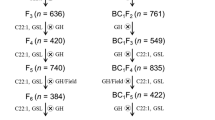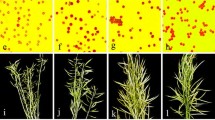Abstract
The oilseed Brassica rapa flowers and matures earlier than B. oleracea, as well as their amphidiploid B. napus. Therefore, earliness of B. rapa has been investigated as a source of variation for earliness in B. napus breeding programs. Variation for days to flower exists in B. oleracea; however, its earliest flowering variant B. alboglabra flowers 2–3 weeks later than B. napus. We hypothesized that the C genome of B. alboglabra carries alleles for early flowering which are different from the C-genome alleles of B. napus; and these alleles can be used for the improvement of B. napus. To test this, we examined flowering time in pedigree and DH populations from two B. napus × B. alboglabra crosses. A B. napus line with about a week earlier flowering than the B. napus parent was achieved through reconstitution of its C genome following pedigree selection. Introgression of the B. alboglabra allele in the early flowering pedigree lines is also evident from the presence of B. alboglabra-specific SSR alleles in this line. However, application of doubled haploidy failed to generate any line that flowered earlier than the B. napus parent, which is probably due to the difficulty of obtaining large numbers of euploid B. napus DH lines from this interspecific cross. Thus, we demonstrate that a trait of the diploid species, which apparently looks undesirable, might in fact be highly valuable for the improvement of amphidiploids; and knowledge from this research can also be applied for other traits.

Similar content being viewed by others
References
Baggett JR, Kean D (1989) Inheritance of annual flowering in Brassica oleracea. Hortic Sci 24:662–664
Bennett RA, Thiagarajah MR, King JR, Rahman MH (2008) Interspecific cross of Brassica oleracea var. alboglabra and B. napus: effects of growth condition and silique age on the efficiency of hybrid production, and inheritance of erucic acid in the self-pollinated backcross generation. Euphytica 164:593–601
Bohuon EJR, Ramsay LD, Craft JA, Arthur AE, Marshall DF, Lydiate DJ, Kearsey MJ (1998) The association of flowering time quantitative trait loci with duplicated regions and candidate loci in Brassica oleracea. Genetics 150:393–401
Butruille DV, Guries RP, Osborn TC (1999) Linkage analysis of molecular markers and quantitative trait loci in populations of inbred backcross lines of Brassica napus L. Genetics 153:949–964
Camargo LEA, Osborn TC (1996) Mapping loci controlling flowering time in Brassica oleracea. Theor Appl Genet 92:610–616
Canadian Food Inspection Agency (1999) The Biology of Brassica rapa L. Regulatory Directive, Dir 1999–02, Plant Health and Production Division, Plant Biotechnology Office, Canadian Food Inspection Agency, Government of Canada, p 18
Cruz VMV, Luhman R, Marek LF, Rife CL, Shoemaker RC, Brummer EC, Gardner CAC (2007) Characterization of flowering time and SSR marker analysis of spring and winter type Brassica napus L. germplasm. Euphytica 153:43–57
Ferreira ME, Satagopan J, Yandell BS, Williams PH, Osborn TC (1995) Mapping loci controlling vernalization requirement and flowering time in Brassica napus. Theor Appl Genet 90:727–732
Hasan M, Seyis F, Badani AG, Pons-Kühnemann J, Friedt W, Lühs W, Snowdon RJ (2006) Analysis of genetic diversity in the Brassica napus L. gene pool using SSR markers. Genet Resour Crop Evol 53:793–802
Kubik TJ, Hawkins GP, Stringam GR (1999) Cytological stability of doubled haploid lines derived from interspecific crosses between B. napus L. and B. rapa L. Proc.10th Int. Rapeseed Congr., Canberra, Australia
Lagercrantz U (1998) Comparative mapping between Arabidopsis thaliana and Brassica nigra indicates that Brassica genomes have evolved through extensive genome replication accompanied by chromosome fusions and frequent rearrangements. Genetics 150:1217–1228
Lagercrantz U, Lydiate DJ (1996) Comparative genome mapping in Brassica. Genetics 144:1903–1910
Long Y, Shi J, Qiu D, Li R, Zhang C, Wang J, Hou J, Zhao J, Shi L, Beom-Seok P, Choi SR, Lim YP, Meng J (2007) Flowering time quantitative trait loci analysis of oilseed Brassica in multiple environments and genomewide alignment with Arabidopsis. Genetics 177:2433–2444
Makarevitch I, Phillips RL, Springer NM (2008) Profiling expression changes caused by a segmental aneuploid in maize. BMC Genomics 9:7. doi:10.1186/1471-2164-9-7
Mei DS, Wang HZ, Hu Q, Li YD, Xu YS, Li YC (2009) QTL analysis on plant height and flowering time in Brassica napus. Plant Breed 128:458–465
Miller TA (2001) Agronomic and quality performance of three doubled haploid lines derived from a Brassica napus/Brassica rapa interspecific cross. M.Sc. thesis, University of Alberta, Edmonton, Canada, pp 79
Möllers C, Iqbal MCM, Röbbelen G (1994) Efficient production of doubled haploid Brassica napus plants by colchicine treatment of microspores. Euphytica 75:95–104
Nishioka M, Tamura K, Hayashi M, Fujimori Y, Ohkawa Y, Kuginuki Y, Harada K (2005) Mapping of QTLs for bolting time in Brassica rapa (syn. campestris) under different environmental conditions. Breed Sci 55:127–133
Okazaki K, Sakamoto K, Kikuchi R, Saito A, Togashi E, Kuginuki Y, Matsumoto S, Hirai M (2007) Mapping and characterization of FLC homologs and QTL analysis of flowering time in Brassica oleracea. Theor Appl Genet 114:595–608
Osborn TC, Kole C, Parkin IAP, Sharpe AG, Kuiper M, Lydiate DJ, Trick M (1997) Comparison of flowering time genes in Brassica rapa, B. napus and Arabidopsis thaliana. Genetics 146:1123–1129
Palmer JD, Shields CR, Cohen DB, Orton TJ (1983) Chloroplast DNA evolution and the origin of amphidiploid Brassica species. Theor Appl Genet 65:181–189
Prakash S, Hinata K (1980) Taxonomy, cytogenetics and origin of crop Brassicas, a review. Opera Bot 55:1–57
Qian W, Chen X, Fu D, Zou J, Meng J (2005) Intersubgenomic heterosis in seed yield potential observed in a new type of Brassica napus introgressed with partial Brassica rapa genome. Theor Appl Genet 110:1187–1194
Rae AM, Howell EC, Kearsey MJ (1999) More QTL for flowering time revealed by substitution lines in Brassica oleracea. Heredity 83:586–596
Rahman MH (2001) Production of yellow seeded Brassica napus through interspecific crosses. Plant Breed 120:463–472
Ringdahl EA, McVetty PBE, Sernyk JL (1986) Inheritance of earliness, height, and leaf number in crosses of early maturing rapeseed. Can J Genet Cytol 28:1009–1015
Rohlf FJ (2001) NTSYS-pc numerical taxonomy and multivariate analysis system. Exeter Publ., Setauket
SAS Institute (2004) SAS/Stat User’s Guide, Version 9. SAS Institute Inc., Cary, NC
Schranz ME, Quijada P, Sung S-B, Lukens L, Amasino R, Osborn TC (2002) Characterization and effects of the replicated flowering time gene FLC in Brassica rapa. Genetics 162:1457–1468
Song KM, Osborn TC, Williams PH (1988) Brassica taxonomy based on nuclear restriction fragment length polymorphisms (RFLPs). 1. Genome evolution of diploid and amphidiploid species. Theor Appl Genet 75:784–794
Stringam GR, Degenhardt DF, Thiagarajah MR, Bansal VK (2000) Hi-Q summer rape. Can J Plant Sci 80:835–836
U N (1935) Genome-analysis in Brassica with special reference to the experimental formation of B. napus and peculiar mode of fertilization. Jpn J Bot 7:390–452
Zaman MW (1988) Limitations for introgression of yellow seed colour in Brassica napus. Sver Utsädesfören Tidskr 98:157–161
Zhao J, Paulo M-J, Jamar D, Lou P, van Eeuwijk F, Bonnema G, Vreugdenhil D, Koornneef M (2007) Association mapping of leaf traits, flowering time, and phytate content in Brassica rapa. Genome 50:963–973
Acknowledgments
Funding by Natural Sciences and Engineering Research Council of Canada (NSERC) as Discovery grant and Alberta Canola Producers Commission (ACPC) to the first author is gratefully acknowledged. Thanks are also extended to the personnel of the Canola Program of the University of Alberta for technical assistance.
Author information
Authors and Affiliations
Corresponding author
Electronic supplementary material
Below is the link to the electronic supplementary material.
Rights and permissions
About this article
Cite this article
Rahman, M.H., Bennett, R.A., Yang, RC. et al. Exploitation of the late flowering species Brassica oleracea L. for the improvement of earliness in B. napus L.: an untraditional approach. Euphytica 177, 365–374 (2011). https://doi.org/10.1007/s10681-010-0253-5
Received:
Accepted:
Published:
Issue Date:
DOI: https://doi.org/10.1007/s10681-010-0253-5




